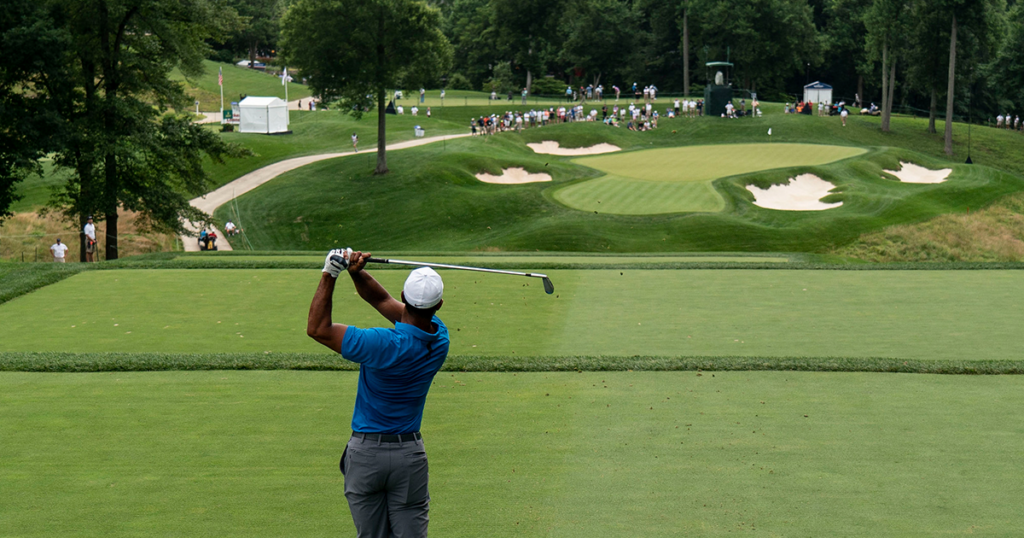
Tiger Woods was done. His body had betrayed him, his back had given out, his life had unraveled in such a humiliatingly public fashion that he was never going to be the same on the golf course. Never again would he be the man who hobbled around Torrey Pines at the 2008 U.S. Open on a leg with two stress fractures and a torn ACL and yet somehow managed to win his 14th—and possibly his last—major championship. At the beginning of 2018, he was ranked 656 in the world. The faint half-life of his storied career had all but expired.
Now, suddenly, dramatically, he’s back. In late July, at the British Open at Carnoustie, Scotland, Woods briefly led in the final round before finishing tied for sixth. And at the recent PGA Championship at Bellerive in St. Louis, he flirted with destiny on the back nine, the raucous swarm of spectators cheering his unlikely charge, before finishing second, two shots back.
We are witnessing one of the most astonishing second acts in sporting history. One thinks of Ted Williams returning to baseball after more than a year, when he served as a pilot in the Korean War, and cementing his legacy as one of the greatest old hitters in baseball. Of Michael Jordan retiring, and, after failing to master the intricacies of the curveball during a short-lived minor-league baseball career, leading the Bulls to three more NBA titles. Of the celebrated Spanish matador Juan José Padilla losing his left eye after a ghastly goring, before returning to the ring in his “suit of lights” to again face off against thousand-pound bulls. Of Andre Agassi plummeting to 141 in the world rankings, and dabbling in crystal meth as he all but vanished from tennis, before becoming the oldest ever world number one, at age 33 (Roger Federer now owns the record). And of Serena Williams experiencing a harrowing childbirth last September, then making the Wimbledon finals this summer in her typically resilient fashion.
Yet there’s nothing quite like what we’re seeing now, nothing with a narrative arc that resembles Woods’s fall from grace and his return to the hot glow of the sporting spotlight. It was nearly a decade ago that his ex-wife, Elin Nordegren, reportedly took one of his golf clubs to his Cadillac Escalade and exposed his sordid secret life to the world. The man who had named his yacht Privacy and a smaller boat Solitude had been laid bare, with no shortage of schadenfreude from fans who had despised him for the yawning gulf between his manufactured persona and real-life one—for his adultery and for his suspected use of performance-enhancing drugs (no hard evidence has ever substantiated these rumors), for the fact that he dropped f-bombs on live television after wayward tee shots.
There were moments in recent years when Woods looked like a middle-aged hacker as he slashed his way around a golf course—topping three-woods, blading chip shots. Imagine Joshua Bell struggling to play “Chopsticks,” or Magnus Carlsen getting checkmated by a chess hustler. Woods’s body seemed to have reached the end of its useful athletic life, the accumulated damage from the torque of his swing (and various stints training with the Navy SEALs) leading to multiple back surgeries. Woods had all but become a Florida retiree before his time, his primary form of exercise at one point his daily walk. As all great athletes inevitably must, he was forced to stare into the abyss of his post-sports future and consider how he would leave behind the hyper-charged rhythms of competition that had defined almost his entire life. “The thing is,” Michael Jordan told Wright Thompson in a 2016 ESPN story about Woods, “I love him so much that I can’t tell him, ‘You’re not gonna be great again.’”
But there was Tiger at Bellerive, once again navigating the course with his inimitable aesthetic, self-contained and resolute as he fashioned recovery shots from the rough, seemingly possessing again his otherworldly ability to tilt the proceedings in his favor. When was the last time we had seen Woods like this? How does it feel to rediscover a long-lost version of oneself? I watched with a true sense of wonder. Woods himself appeared to exhibit a childlike disbelief at his performance when, after holing a birdie putt on 18, he let loose a throwback fist pump.
The detractors will argue that Woods won’t be truly back until he wins another major. The detractors will lament that the media spill more ink about Woods than the players who are actually winning the tournaments. Indeed, having laid waste to Woods’s storybook image, the media have started in on the next phase, the rehabilitative one, in which Woods becomes the sentimental favorite, the Prodigal son returned. Many pundits pointed out that Woods stayed behind after his final round in St. Louis to congratulate Brooks Koepka after his victory, a simple courtesy the old Woods would never have suffered. Whether he’s changed or not, whether you can forgive him for his moral failings or not, his reemergence is an unexpected revelation.

